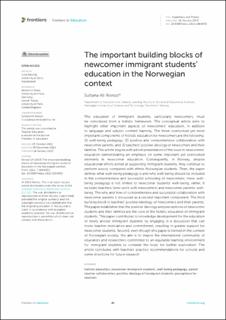| dc.description.abstract | The education of immigrant students, particularly newcomers, must be considered from a holistic framework. The conceptual article aims to highlight other important aspects of newcomers’ education, in addition to language and subject content learning. The three overlooked yet most important components of holistic education for newcomers are the following: (1) well-being pedagogy, (2) positive and comprehensive collaboration with newcomer parents, and (3) teachers’ positive ideology of newcomers and their families. This article begins with a brief presentation of the issue in newcomers’ education demonstrating an emphasis on some important yet overlooked elements in newcomer education. Consequently, in Norway, despite educational efforts aimed at supporting immigrant students, they continue to perform poorly compared with ethnic Norwegian students. Then, the paper defines what well-being pedagogy is and why well-being should be included in the comprehensive and successful schooling of newcomers. Here, well-being pedagogy is not limited to newcomer students’ well-being; rather, it includes teachers (who work with newcomers) and newcomer parents’ well-being. The why and how of comprehensive and successful collaboration with newcomer parents is discussed as a second important component. The third building block is teachers’ positive ideology of newcomers and their parents. The paper establishes that the positive ideology and perceptions of newcomer students and their families are the core of the holistic education of immigrant students. This paper contributes to knowledge development for the education of newly arrived immigrant students by engaging in a discussion that can foster teacher motivation and commitment, resulting in greater support for newcomer students. Second, even though this paper is framed in the context of Norwegian society, the aim is to inspire the international community of educators and researchers committed to an equitable learning environment for immigrant students to consider the topic for further exploration. The article concludes with teachers’ practice recommendations for schools and some directions for future research. | en_US |

